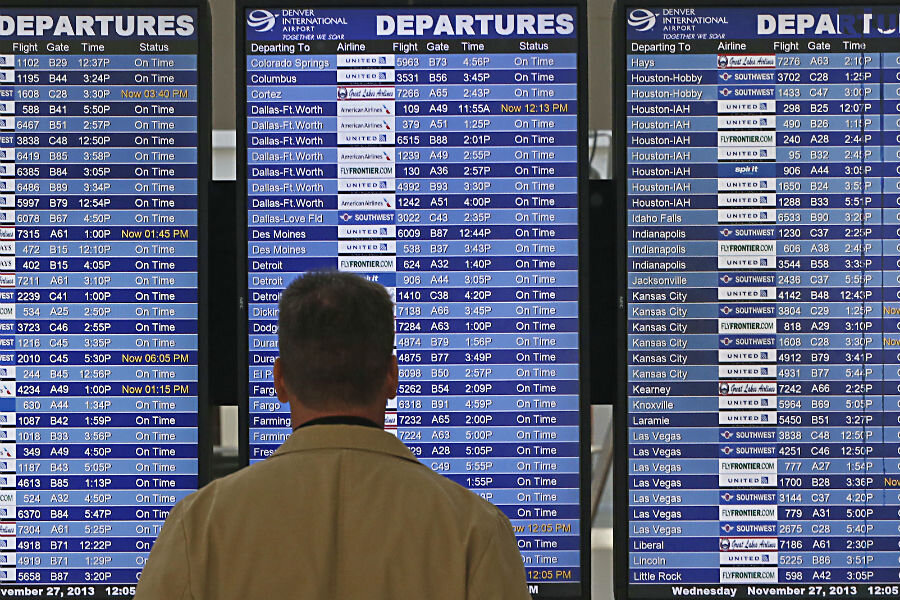Ten travel tips for navigating Thanksgiving storms
Loading...
Next weekend, 46.9 Americans will hit the road for the holiday, according to the American Automobile Association: nearly 15 percent of the nation is traveling more than 50 miles to be with loved ones for Thanksgiving dinner. But how many of them will arrive on time is anybody's guess.
With gasoline at $2.15 per gallon, down 74 cents from last November, more families will be traveling than in any year since 2007, when the recession put a damper in many people's travel plans.
Nearly 90 percent will be driving, but lobbying group Airlines for America predicts 25.3 million will fly, an increase of 3 percent from 2014.
That scale of airline travelers – and the season – could create delays, cancellations, and just about every inconvenience that could delay a reunion. El Niño isn't helping: meteorologists blame raised temperatures in the Pacific for blizzard conditions that canceled hundreds of flights in Colorado this week, before continuing on towards Kansas.
Here are some tips to help you and your family arrive on time, if problems arise at the airport (or before):
1. The Early Bird: if it's not too late to change your plans, consider flying early. Not just earlier in the week, although that helps: take the first flight you can find, before a day's worth of delays and cancellations have time to ruin your flight, too.
2. Pack light: Do you really need a suitcase? Resist the urge to over-pack for what's probably just a weekend away; you'll roll in and out of the airport faster. If checked baggage is lost, it can take days to make its way to your destination: probably too late for a quick trip home.
3. Back up tags: But if you do bring bags, tuck an itinerary inside – not just your name and number, but flight schedules, hotel info, or family contacts. Just in case luggage tags are eaten up by a conveyer belt, you'll increase chances that bags wind up where you want them.
4. Spot your bag: There's a unique despair to watching the baggage claim carousel go round and round as you fear your suitcase will never appear. Make it easier to spot yours by staying away from stickers or ribbons to make it stand out — again, conveyer belt tumbles might tear them off, leaving you back at square one with an unadorned bag. Spring for a brightly colored or patterned suitcase instead, US Airways supervisor Chris Gossner told Real Simple.
5. Pack even lighter: Even your carry-on might wind up out of sight if there's not room in the overhead bin. Make sure yours is small enough to tuck under a seat.
6. Critter carry-on? Double-check with your airline before you count on bring any creatures with you. Many dogs and cats can travel in the cabin with you, but the US Department of Transportation says that some carriers won't allow "snub-nosed and pug-nosed dogs and cats."
7. Back-up ticket: If you think mechanical problems will ground the flight, the Associated Press' Scott Mayerowitz recommends asking the airline to "protect" a ticket for you on the next plane out. That ticket will be confirmed as soon as a cancellation is announced.
8. Who you gonna call? In case of delay, do wait in line to speak to a customer service rep, but multitask: call the airline, or even Tweet at them. Mr. Mayerowitz suggests trying the international phone number, too: what you pay in overseas fees, you could make up for in a shorter wait time.
9. Got kids? You've finally made it onboard, but your neighbors are eyeing your children warily. If you're feeling awfully generous (or just afraid of passenger complaints), consider following the example of one Florida-bound couple flying with their baby for the first time, who made up "goody bags" for nearby travelers to apologize in advance for any wailing that ensued.
10. TSA Pre-Check pass: Once you're back home, guarantee an even better trip next time by registering for the TSA's "Pre√" expedited security check program: i.e., once you're enrolled, you can zoom through security without removing liquids, shoes, or laptops. It's probably too late for Thanksgiving, but might make Christmas that much easier.
This report includes material from the Associated Press.








